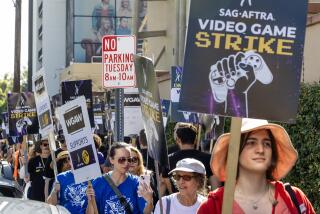Spotlight in Labor Drama Shifts to Actors’ Guilds
- Share via
Now that writers have reached a tentative agreement, it is the actors’ turn to take center stage in this year’s Hollywood labor drama.
The 135,000 actors represented by the Screen Actors Guild and the much smaller American Federation of Television and Radio Artists will soon begin negotiations with the major studios on a new three-year contract. The existing contract expires July 1.
The actors’ demands are expected to mirror many of the money issues that concerned writers, such as residuals paid when TV programs rerun on cable TV and in foreign markets. SAG also is concerned that many of its veteran actors barely make above-scale minimums in dozens of work categories and plans to lobby for better diversity programs.
But unlike the writers, SAG and AFTRA are among the most stubborn negotiating groups that the studios will bargain with. Last year, the two actors’ guilds staged a bitter six-month strike against advertisers.
SAG is also a notoriously fractious union that has been plagued by infighting, feuds with AFTRA and battles between more militant Los Angeles members and officials in outlying offices. With 105 board members, the union is a bloated bureaucracy.
In addition, SAG took a more rigorous stance in late 1999, when a successful coup by a dissident group toppled the regime of former President Richard Masur. Emmy-winning actor William Daniels was elected instead.
Still, the writers settlement, combined with a softening economy, bruises from last year’s strike and the hiring of experienced entertainment labor negotiator Brian Walton, has eased fears that it might be difficult to negotiate a new contract.
Daniels and Walton are going out of their way to talk down the possibility of a strike, saying it only leads to unnecessary hysteria.
“There is simply no need for the leadership of SAG and AFTRA to trumpet its strike option,” Walton said in a message to members last month. “Everyone knows it is there and will be used by a well-educated and determined membership, who is left with no option by a nonresponsive group of employers.”
That calmed-down rhetoric comes in the wake of news that last year’s strike cost SAG members about $100 million in lost earnings, although it did galvanize members and brought out major stars such as Tom Hanks, Julia Roberts, Susan Sarandon and Kevin Spacey to support the union.
Helping to further calm strike fears was an announcement last weekend by SAG and AFTRA that the proposals are “thought to be one of the most streamlined and focused in the history of these negotiations,” sending a message that it was casting aside many of the numerous minor issues that have historically slowed talks. In 1998, for example, SAG and AFTRA submitted 34 pages of proposals, down to provisions on where extras should change their clothes.
Ira Shepard, the labor lawyer who negotiated for management in the commercial strike, said a writers settlement goes a long way toward helping prevent an actors’ strike.
“It reduces the climate of confrontation. It will really put the pressure on SAG to exercise their power with great, great discretion,” Shepard said.
More to Read
The biggest entertainment stories
Get our big stories about Hollywood, film, television, music, arts, culture and more right in your inbox as soon as they publish.
You may occasionally receive promotional content from the Los Angeles Times.










